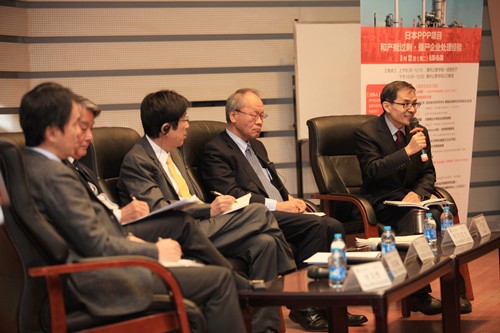CIDEG Forum on “Japan’s PPP Projects and Experience in Dealing with Zombie Company”Release time: 2016-05-30

On March 22nd, the CIDEG Forum on “Japan’s PPP Projects and Experience in Dealing with Zombie Company” was held at the auditorium of the School of Public Policy and Management, Tsinghua University (SPPM). Prof. HATTA Tatsuo, Director of Asian Growth Research Institute and Member of Council of National Strategic Special Zones, Prof. MIHARA Toru, Fellow of Mitsui Global Strategic Studies Institute, Mr. AKAHANE Takashi, Partner of Anderson Mori & Tomotsune, Prof. SUGITA Sadahiro, Visiting Professor at Waseda University, Mr. TSUGAMI Toshiya, President of Tsugami Workshop Ltd. and Research Fellow of CIDEG, were invited to make keynote speeches. Mr TOKUCHI Tatsuhito, Former Managing Director of CITIC Securities Corporation and CIDEG Board Member, hosted the forum. Mr CHEN Qingtai, Former Dean of SPPM, Former Deputy Director of the Development Research Center of the State Council and Chairman of CIDEG Board, made a welcome speech. Prof. YU An, Fellow of SPPM, and Mr ZHU He, Researcher of Caixin Think Tank attended as commentators. Mrs XIAO Meng, Senior Editor of Journal of Comparative and CIDEG Board Member, Dr CHEN Ling, Vice Director of CIDEG and Associate Professor of SPPM, and around one-hundred teachers and students inside and outside Tsinghua University attended the forum.
Chairman of CIDEG Board, Mr CHEN Qingtai first welcomed the Japanese experts. He said that the PPP projects for municipal infrastructure construction and public service had drawn increasing attention by Chinese government and enterprises because it was a significant part of China’s government reform and an important way to expand the private economy. Another hot spot in the reform was de-capacity and dealing with zombie enterprises, which perplexed government and enterprises during the industrial upgrading. It has been more than twenty years since the PPP projects appeared in Japan. Japan’s experience in PPP projects and dealing with zombie companies was very useful for China. Mr CHEN believed that participants would benefit from these lectures and discussions.
The first session in the morning was entitled “Japan’s Experience in PPP projects”. The keynote speeches were made by Prof. HATTA Tatsuo, Prof. MIHARA Toru, Mr AKAHANE Takashi, Prof. SUGITA Sadahiro. First is the lecture entitled “City and Economic Growth: Why Japan’s Economic Growth Decline in 1974” by Prof. HATTA Tatsuo. He showed the economic growth in Japan at the postwar period by data and pointed out that total factor productivity increase was the main reason for Japan’s rapid economic growth. In the early 70s, the “Balanced Development Policy” was carried out in Japan, which led to the end of immigrant waves from low productivity area to high productivity area. Although the intention was good, the policy was regarded to cause the slowdown of economic growth.
The lectures on the development of Japan’s PPP projects by Prof. MIHARA Toru, Mr AKAHANE Takashi, Prof. SUGITA Sadahiro are followed. Prof. MIHARA Toru delivered a lecture entitled “Experience from the successes and failures in PPP/PFI in Japan”. He listed features of Japan’s PPP projects generally and cited PPP projects such as prisons, Sendi Airport and refurbishment of Fukuoka City Children’s Science & Culture Center to explain why PPP projects succeed. Prof. MIHARA Toru also pointed out the main reasons for failures of PPP projects, including the crisis of confidence, financial problems, poor communication, decision-making mistakes and frustration of contract. He concluded that keys to successful PPP projects were information disclosure, accountability mechanisms, the spirit of contract and risks allocation and aims of PPP projects should be not only to lighten financial burdens but in pursuit of higher values. Mr. AKAHANE Takashi introduced Japan’s experience in PPP/PFI from a legal perspective. He emphasized the importance of risks allocation to projects and by analyzing cases such as Sendi Airport and Mine Rehabilitation Program Center he illustrated the different roles government and non-government organizations played in risks allocation. Prof. SUGITA Sadahiro made a speech on “The trend of PPP and Its Spread in East Asian Region”. He regarded PPP/PFI as not only a part of fiscal reform but also an incentive to productivity improvement. He listed seven key points of PPP/PFI projects to provide developing countries with experience in projects design and innovation.
Prof. YU An commented on the first session. He said that it was an outstanding exploration for Japan to introduce PPP by legislation in the late 90s. Japan’s successful experience and policies were worth learning, but further exploration should continue.
The second session in the afternoon was the lecture entitled “Dealing with Excess Capacity and Zombie Companies: Japan’s Experience” by Mr TSUGAMI Toshiya. He introduced that the way of dealing with excess capacity changed in the process of transformation from a planned economy to market economy in Japan. Japanese government firstly tried to take capacity off by cartel, which was anti-competitive. After 70s, the government helped distressed firms and laid-off workers by making laws and policies. To rebuild zombie companies, Mr. TSUGAMI Toshiya advised restructuring operation, laying off employees and recruiting new team according to some guiding principles. Then rebuilt companies should be re-evaluated and discharged of a debt beyond their capabilities.
Mr. CHEN Qingtai delivered concluding remarks. He stated that Chinese government could learn from Japan’s experience during the period of structural reform and economic changes. The government should take excess capacity off and create a good condition for reform.
